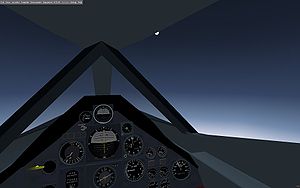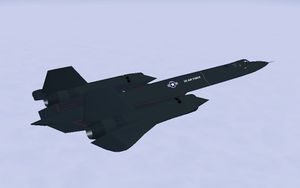Lockheed SR-71 Blackbird
 | |
|---|---|
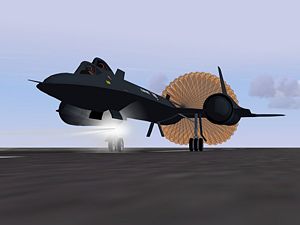 | |
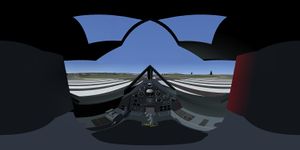 A full spherical panorama of the Lockheed SR-71 Blackbird 3d cockpit | |
| Type | Strategic aircraft, Reconnaissance aircraft, Military aircraft, Historical aircraft |
| Configuration | Delta-wing aircraft |
| Propulsion | Jet aircraft, Single-engine aircraft |
| Manufacturer | Lockheed |
| Author(s) |
|
| FDM | JSBSim |
| --aircraft= |
Blackbird-A Blackbird-B |
| Status | Early production |
| FDM |
|
| Systems |
|
| Cockpit |
|
| Model |
|
| Development | |
| Hangar | GRTux hangar |
| Website |
|
| Repository |
|
| Download |
|
| License | GPLv2+ |
|
| |
This includes the following models: SR-71A, SR-71B
The Lockheed SR-71 is an advanced, long-range, Mach 3 strategic reconnaissance aircraft developed from the Lockheed A-12 and YF-12A aircraft by the Lockheed Skunk Works. The SR-71 was unofficially named the Blackbird, and called the Habu by its crews. Clarence "Kelly" Johnson was responsible for many of the design's advanced concepts. A defensive feature of the aircraft was its high speed and operating altitude, whereby, if a surface-to-air missile launch were detected, standard evasive action was simply to accelerate. The SR-71 line was in service from 1964 to 1998, with 12 of the 32 aircraft being destroyed in accidents, though none were lost to enemy action.
Aircraft help
Startup
- Press } to toggle the master electric switch.
- Press space or s to activate the starter. The engine will spin up to a maximum of about 25% N2 (5.2% N1).
- After reaching 15% N1, press { to turn off the cutoff to let the engines start. Wait for the EP Ratio needle to come close to 1.1.
- Don't forget to press d to close the canopy.
- Release the parking brake, put the throttle to max and takeoff.
Landing
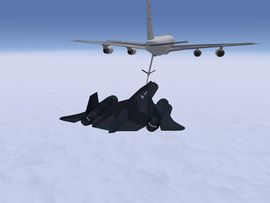
Braking chute
The braking chute will be automatically deployed if:
- Brake chute doors are opened (Ctrl-b).
- Airspeed is less than 200 kts.
- AGL is lees than 20 ft.
- Throttle positions are less than 0.1.
The braking chute will be released/untied if:
- Airspeed is less than 50 kts.
Remember: it can be used only once. If you want to use it again you have to reload (j).
Flight Manual
There is an actual Flight Manual available online if you want to know the full operating procedures of the aircraft - not all operations are supported by the model though. Here is an abbreviated version geared to what is available and possible in Flightgear.
Pre-flight preparations
Select a destination and enter it into the route manager. The real SR-71 has an Astro-Inertial Navigation System (ANS) which is capable of navigating a preset series of waypoints just as the route manager. For a first flight, a distance to destination of about 1500 nm is suitable, the flight time is then about 1 hour with sufficient time to climb up to cruising altitude and spend some 15-20 minutes cruising. For better performance, reduce the fuel level accordingly. With full tanks, the Blackbird should have a range of 2900 nm, so 2/3 of normal fuel should be ample. Note that navigating by sight like following a coastline is quite impossible from 80.000 ft - it takes about 30.000 m visibility to see the ground directly beneath the aircraft, and at least 10 times this much to see anything from the cockpit. This is asking for really good weather in reality, and definitely not viable in the simulation - so the ANS is the only real option.
It also can't hurt to have some background knowledge about supersonic high-altitude flight - Understanding Supersonic Flight and Understanding airspeed measures provide some useful background to understand why the plane must be operated the way it is.
Takeoff
Start the electric system (}), start the engines (s), watch the engines spin up to 15% N1, then turn off the cutoff ({) and wait for the engines to become operational. Close the canopy (d), release parking brakes (shift-b) and taxi to the runway. Put the throttle to full afterburner power and rotate at about 200 KEAS (knots equivalent airspeed), retract gear (g) after liftoff. Climb out at about 250 KEAS.
Subsonic climb
The Blackbird is not exactly a nimble plane in the subsonic regime, but all in all handles well. After getting the okay from ATC, turn towards the destination (you may get the autopilot to lock on that heading) and start climbing while steadily accelerating towards Mach 1. Leave the throttle at full thrust (in fact, thrust will remain on full afterburner power all the way till the beginning of the descent). Climb below Mach 1 towards 25.000 ft. This is the usual air-air refueling altitude for the SR-71, so in a more complicated flightplan taking off with a small load of fuel, you would now find the tanker and fill the tanks. This is also a good opportunity for final changes of the heading - turning at Mach 3 costs a lot of time and fuel and should be avoided if possible.
Supersonic climb
While having a simulated autopilot fly a simulated plane is in general a bit odd, letting the autopilot handle the Blackbird in supersonic flight is worth considering, as it makes life much easier. The reason is that at high velocities, even a small-angle descent immediately leads to a very impressive sinkrate, so the plane needs to be controlled very precisely. But at the same time, the response of the plane at high altitude is increasingly sluggish, and overcorrecting happens easily. In addition, the plane rolls easily and it costs a lot of attention to control course. While small deviations from the optimal climb path just cost more fuel, larger deviations may mean that you have to descend and climb back again. The autopilot can handle the required maneuvering more efficient.
In any case, it is time to go supersonic. Dependent on conditions, the procedure is to either climb to 33.000 ft with Mach 0.99 and reach Mach 1.25 in a shallow descent to 30.000 ft, or to accelerate to Mach 1.25 in level flight at 25.000 ft. After reaching Mach 1.25, start climbing again.
The plane is now flown on a climbing trajectory of constant 450 KEAS. At higher altitude, this corresponds to increasingly higher Mach numbers. The climb is not particularly fast - just keep climbing slowly and steadily. At about 70.000 feet, allow reduction down to 400 KEAS when climbing to 80.000 ft, there level off - you should be able to reach Mach 3.2 or more, dependent on fuel load. When the fuel load is light, consider climbing to 85.000 ft for better efficiency. Cruise and watch the distance to destination melt away.
Descent
About 230 miles to destination, prepare for descent. Switch afterburner off and reduce thrust to military power. Keep the altitude until the plane decelerates to 350 KEAS, then start descending keeping this airspeed. The descent is again rather shallow, and it should take about 200 miles to get to 25.000 ft, at which point you can safely switch off the autopilot and fly the rest of the trip yourself.
Approach and landing
Fly the approach pattern of your choice to the destination runway. Reduce airspeed to about 220 KEAS below 10.000 ft, turn into final approach with about 200 KEAS. Watch the speed, especially when making tight turns in the approach pattern. The Blackbird is a supersonic aircraft with bad aerodynamics in subsonic flight - if you stall, there's little chance to recover. Arm the braking chute (ctrl-b), on final approach extend gear (shift-g) and prepare for landing.
Thanks to the magnificent view from the cockpit, you can't actually see straight ahead, i.e. you don't see the runway in a straight approach. There are three possible solutions: First, you could modify the viewpoint to simulate a pilot trying to put his head to the side. Second, you can approach at a shallow angle and only align with the runway when you are practically over it - in this way it can be seen better. Or you fix your eyes on a point next to the runway and fly an approach with this reference - if done correctly, that should get you on the runway. Touchdown with about 200 KEAS, put throttle to idle and watch the braking chute open and reduce speed quickly. Apply brakes (b) and use rudder to stay on the runway.
Then taxi to your parking position, apply parking brakes (shift-b), switch off the engines ({), the electrical system (}) and open the canopy (d).
| ||||||||
